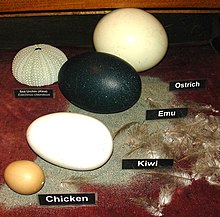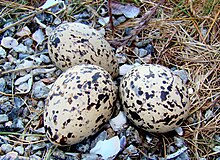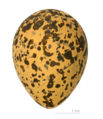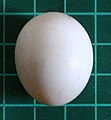Bird egg

Bird eggs are laid by the females and incubated for a time that varies according to the species; a single young hatches from each egg. Average clutch sizes range from one (as in condors) to about 17 (the grey partridge). Clutch size may vary latitudinally within a species. Some birds lay eggs even when the eggs have not been fertilized; it is not uncommon for pet owners to find their lone bird nesting on a clutch of infertile eggs, which are sometimes called wind-eggs.
Colors

The default color of vertebrate eggs is the white of the calcium carbonate from which the shells are made, but some birds, mainly passerines, produce colored eggs. The pigments biliverdin and its zinc chelate give a green or blue ground color, and protoporphyrin produces reds and browns as a ground color or as spotting.
However, the photographic markings on passerine eggs have been suggested to reduce brittleness by acting as a solid state lubricant.[1] If insufficient calcium is available in the local soil, the egg shell may be thin, especially in a circle around the broad end. Protoporphyrin speckling compensates for this, and increases inversely to the amount of calcium in the soil.[2]
For the same reason, later eggs in a clutch are more spotted than early ones, as the female's store of calcium is depleted.
Birds which build in trees generally have blue or greenish eggs, either spotted or unspotted, while birds that build in bushes or near or on the ground are likely to lay speckled eggs.
The color of individual eggs is also genetically influenced, and appears to be inherited through the mother only, suggesting the gene responsible for pigmentation is on the female-specific W chromosome (female birds are WZ, males are ZZ).
Color was once thought to be applied to the shell immediately before laying, but this research shows coloration is an integral part of the development of the shell, with the same protein responsible for depositing calcium carbonate, or protoporphyrins when there is a lack of that mineral.
In species such as the common guillemot, which nest in large groups, each female's eggs have very different markings, making it easier for females to identify their own eggs on the crowded cliff ledges on which they breed.
Shell
Bird eggshells are diverse. For example:
- Cormorant eggs are rough and chalky
- Tinamou eggs are shiny
- Duck eggs are oily and waterproof
- Cassowary eggs are heavily pitted
Tiny pores in a bird eggshell allow the embryo to breathe. The domestic hen's egg has around 7500 pores.
Shape
The shape of eggs varies considerably across bird species, ranging from near-spherical (such as those of the little bee-eater) to highly pyriform or conical (such as those of the common murre) with the familiar shape of the chicken egg lying in between. Early scientific investigators of egg shape [3] suggested that the oval shape of eggs was caused by the egg being forced through the oviduct by peristalsis. In this often-repeated [4][5][6] but incorrect theory of egg shape formation, the contraction and relaxation of the muscles which push the egg down the oviduct cause the spherical egg membrane to distort slightly into an ovoid shape, with the blunt end caudal (i.e. furthest down the oviduct and closest to the cloaca). The calcification of the egg in the shell gland/uterus then fixes it in this shape, and the egg is laid with the blunt end appearing first (for a diagram showing the different sections of the bird oviduct, see here). However, this theory has been refuted by studies of egg shell formation in a number of bird species using techniques such as X-ray photography [7][8] which have demonstrated that egg shape is determined in the oviduct isthmus (before shell calcification) with the pointed end caudal (furthest down the oviduct). These observations cannot be explained by peristalsis. It has been proposed [9] that the egg acquires its shape (with the pointed egg caudal) as it is forced through the narrow isthmus, but this assertion has not been thoroughly verified.
Cliff-nesting birds often have highly conical eggs. They are less likely to roll off, tending instead to roll around in a tight circle; this trait is likely to have arisen due to evolution via natural selection. In contrast, many hole-nesting birds have nearly spherical eggs.
The shape has biological significance. A pointed egg will tend to sit on its side, with the big end tipped upward. The big end contains the air sac and its shell is pierced by a higher density of pores than the more pointed end. Tipping the big end upwards improves oxygen flow to the large head, with the physiologically demanding eyes and brain, that develops in the big end while the tail develops at the more pointed end.
In a 2017 publication in the journal science, mathematical modeling of 50,000 bird eggs data showed that bird egg shape is a product of flight adaptations and not the outcome of nesting conditions or a bird's life history. [10] A strong correlation was found between egg shape and flight ability on broad taxonomic scales, such that birds engaging in high powered flights usually maximize egg size by having elliptical shaped eggs while maintaining a streamlined body plan.[10]
-
Classic oval bird egg (Spur-winged lapwing)
-
Almost spherical bird egg (Senegal parrot)
-
Long, "elliptical" bird egg (Common murre)
Size

Egg size tends to be proportional to the size of the adult bird,[citation needed] from the half gram egg of the bee hummingbird to the 1.5 kg egg of the ostrich. Kiwis have disproportionately large eggs, up to 20% of the female's body weight.[11] This evolutionary trait results in kiwi chicks that can emerge from the nest days after hatching, ready to start foraging for food.
Predation

Many animals feed on eggs. For example, the principal predators of the black oystercatcher's eggs include raccoons, skunks, mink, river and sea otters, gulls, crows and foxes. The stoat (Mustela erminea) and long-tailed weasel (M. frenata) steal ducks' eggs. Snakes of the genera Dasypeltis and Elachistodon specialize in eating eggs. Humans have a long history of both eating wild bird eggs and raising birds for farmed eggs for consumption.
Brood parasitism occurs in birds when one species lays its eggs in the nest of another. In some cases, the host's eggs are removed or eaten by the female, or expelled by her chick. Brood parasites include the cowbirds and many Old World cuckoos.
See also
References
- ^ Solomon, S.E. (1987). Egg shell pigmentation. In Egg Quality : Current Problems and Recent Advances (eds R.G. Wells & C.G. Belyarin). Butterworths, London, pp. 147–157.
- ^ Gosler, Andrew G.; James P. Higham; S. James Reynolds (2005). "Why are birds' eggs speckled?". Ecology Letters. 8 (10): 1105–1113. doi:10.1111/j.1461-0248.2005.00816.x.
- ^ Gunther, F. C. (1792). Sammlung von Nestern und Eyern verschiedener Vogel. Nurnburg
- ^ Ryder, J. A. (1893). Proc. Amer. Phil. Soc. 31, 203.
- ^ Thompson, D'A. W. (1908). Nature, Lond., 78, m, 158.
- ^ Thompson, D'A. W. (1942). On Growth and Form. Cambridge
- ^ Bradfield, J.R.G., 1951. Radiographic studies on the formation of the hen's egg shell. J. Exp. Biol., 28:125-140
- ^ Romanoff, A.L. and A.J. Romanoff, 1949. The Avian Egg. John Wiley and Sons Inc., New York
- ^ Bradfield, J.R.G., 1951. Radiographic studies on the formation of the hen's egg shell. J. Exp. Biol., 28:125-140
- ^ a b Mary Caswell Stoddard, Ee Hou Yong, Derya Akkaynak, Catherine Sheard, Joseph A. Tobias and L. Mahadevan (2017) Avian egg shape: Form, function, and evolution, Science 356 (6344), 1249-1254. DOI: 10.1126/science.aaj1945
- ^ Darren Naish (2009-02-20). "200 years of kiwi research".
Smart, I. H. M., 1991. Egg-shape in birds. Pages 101-106 in D. C. Deeming and M. W. J. Ferguson (eds.). Egg incubation: its effect on embryonic development in birds and reptiles. Cambridge University Press, UK. 448pp.
Further references
Attenborough, D. 1998. The Life of Birds. BBC p.218. ISBN 0563-38792-0



